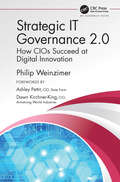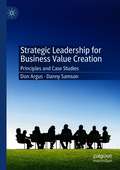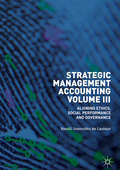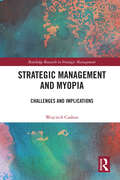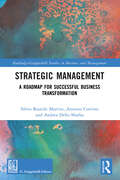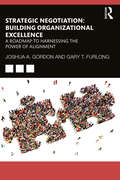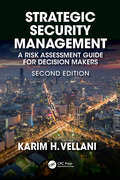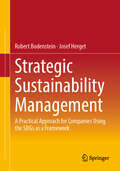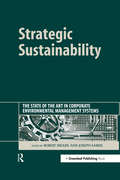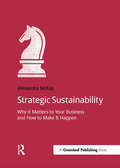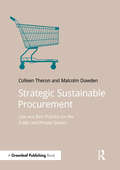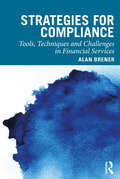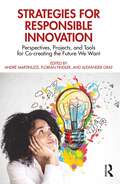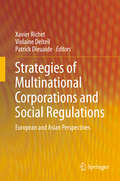- Table View
- List View
Strategic IT Governance 2.0: How CIOs Succeed at Digital Innovation
by Philip WeinzimerWeinzimer provides industry case studies of companies that have implemented multiple components of The Strategic IT Governance 2.0 model. These companies successfully leveraged collaboration between technology and the business to deliver technology projects that provide the best customer value, improve cost efficiencies, and create a governance culture across business areas. In his book, you will learn valuable lessons to implement an innovative governance model for your company.— Ashley Pettit, CIO, and Senior Vice President, Enterprise Technology, State Farm In Strategic IT Governance 2.0, Phil provides a number of exciting case studies of how CIOs are leveraging technology to innovate and create value. They are following Phil's model, building strategic and tactical relationships within the business to drive technology growth strategies, collaborating with partners to improve customer service and increase value with process optimization and best practice metrics. Each of these companies offers a slightly different take on the multiple components of the Strategic IT Governance 2.0 model; however, these organizations' collective and individual success indicates the strength of the components.— Dawn Kirchner-King, Vice President and Chief Information Officer, Armstrong World Industries Today's business environment is more complicated, creating additional challenges for the successful execution of strategic enterprise projects. Unless an organization revisits its governance model, strategic projects are at risk of negatively impacting business success. So, how do companies succeed in overcoming these obstacles to improve project success? Strategic IT Governance 2.0: How CIOs Succeed at Digital Innovation explains how IT executives can take the lead and successfully drive digital transformation initiatives and associated projects. The book presents the Strategic IT Governance 2.0 model that focuses on project alignment, process reinvention, and leadership excellence. It is filled with case studies of the model’s implementation, giving practical insight into how organizations have successfully executed digital transformation.
Strategic Issues in Air Transport: Legal, Economic and Technical Aspects
by Ruwantissa AbeyratneThere are broadly four strategic issues in aviation: safety; security; environmental protection; and sustainability in air transport. These issues will remain for a long time as key considerations in the safe, regular, efficient and economic development of air transport. Within these four broad categories come numerous subjects that require attention of the aviation industry as well as the States. In six chapters, this book engages in detailed discussions on these subjects as they unravelled in events of recent years. The issue of safety is addressed first, following an introduction of the regulatory regime covering the four issues. Within the area of safety, the book covers such areas as safety management systems, safety and aeromedicine, safety and meteorology, the use of airspace, unmanned aircraft systems and safety oversight audits. In the security area, subjects covered include cyber terrorism, the integrity of travel documents, full body scanners, civil unrest and aviation, the suppression of unlawful acts on board aircraft and the financing of terrorism. The chapter on the environment focuses mainly on climate change - particularly on carbon credits, market based measures, the carbon market and emissions trading schemes and their effect on air transport. Finally, the chapter on sustainability discusses in detail market access along with such issues as slot allocation, open skies, the use of alternative fuels as an economic measure and corporate foresight. The concluding chapter wraps up with a discussion on where air transport is headed.
Strategic Leadership for Business Value Creation: Principles and Case Studies
by Danny Samson Don ArgusThis book focuses on leadership and strategy, corporate governance, operational excellence, and corporate social responsibility. In doing so, it offers both conceptual perspectives and case studies on these topics that are targeted at business executives who want to develop and mature towards being successful value creators in their leadership roles. Authored by the former CEO of National Australia Bank (NAB), Don Argus, and business school professor Danny Samson, the book provides insights on the strategic leadership factors that make a significant and positive difference when they are executed effectively and, in contrast, what happens when ineffective leadership/ strategy are deployed. It proposes and illustrates core leadership axioms, and also delves into sustainable development as an element of strategy. The authors do this by developing and illustrating core concepts that relate to the two major case study companies of NAB and BHP.Readers will be particularly interested in the core elements of leadership and strategy, and the grounded reality of how they operated in the case studies. The authors bring insiders’ and leaders’ perspectives to these topics, including tables that document shareholder value creation, and the logic behind strategic decisions, as well as key organisational leadership and strategic decision processes.
Strategic Litigation and Corporate Complicity in Crimes Under International Law: A TWAIL Analysis
by Kalika MehtaThis book provides a comprehensive account of how non-state actors rely on international criminal law as a tool in the service of progressive political causes. The argument that international criminal law and its institutions serve as an instrument in the hands of a few powerful states, and that its practice is characterized by double standards and selectivity, has received considerable attention. This book, however, focuses on a practice that is informed by this argument. Its focus is on an alternative practice within international criminal law, where non-state actors navigate what critical scholars call a structurally biased legal system, in order to achieve long-term political objectives. Innovatively, the book combines the concerns expressed by Third World Approaches to International Law with strategic litigation that focuses on the accountability of corporations for their complicity in crimes under international law. Analysing this litigation, the book demonstrates that, while it is crucial to highlight the blind spots of the international criminal legal framework, it is also important to take into account the practice of non-state actors engaged in leveraging its emancipatory potential. This original analysis of the implementation and legitimacy of international criminal law will be of interest to a wide range of scholars and activists working in relevant areas of law, politics, criminology and international relations.
Strategic Management Accounting, Volume III: Aligning Ethics, Social Performance and Governance
by Vassili Joannidès de LautourThis book responds to key issues in strategic management control by studying the interplay between ethics, social and environmental performance and governance. Grounded in research but written with practitioners and students in mind, it addresses the most up-to-date issues pertaining to ethical insights into management accounting and accountability.
Strategic Management and Myopia: Challenges and Implications (Routledge Research in Strategic Management)
by Wojciech CzakonThis book investigates the phenomenon of strategic myopia, which refers to important cognitive distortions that managers systematically display. It captures narrow views and preferences, which are likely to hurt firms’ long-term prospects. Instead of accusing managers of imperfections, opportunism or blindness, this book explains how strategic myopia stems from individual dispositions, how it is shaped by team contingencies, and encouraged by organisations’ design. The reader will learn how a metaphor introduced to explain business failure evolved over decades to become a concept useful in understanding intertemporal choices, technology substitution, competitive advantage erosion, competitive blind-spots and missed opportunities. In addition to explaining the mechanisms that encourage myopic behaviours, readers are offered a set of effective ways to address strategic myopia. A key benefit of this work is that the structure of the book allows the use of chapters separately. The core message is that eliminating strategic myopia is hardly possible, and may actually hurt the firms’ short-term efficiency. However, organisations may develop capabilities, and implement designs that favour balancing the short-term benefits of myopia and alleviate its long-term drawbacks. This book will be of interest to scholars, researchers, advanced students and experienced managers in the fields of strategic management and organisational behaviour.
Strategic Management: A Roadmap for Successful Business Transformation (Routledge-Giappichelli Studies in Business and Management)
by Silvio Bianchi Martini Antonio Corvino Andrea Dello SbarbaThis book explores the intricate world of strategic management. Blending theory with practical examples, the authors provide a systematic framework for strategic decisionmaking. The book is divided into two parts. It begins by exploring the perspectives of strategic analysis, examining the firm’s “current situation” and “evolutionary” perspectives, as well as the “objective reality” and “subjective perspective”. These interconnected perspectives require different analytical approaches to understand the firm’s present state and the process of change. The second part, entitled “The strategic map: the areas, the pathway and the objects of analysis”, delves deeper into specific areas of strategic analysis. It focuses on the current state of the firm (today’s firm), emphasizing the importance of understanding its resources, products, markets, activities, and stakeholder relationships. The quality and implementation effectiveness of the strategic model are also assessed, providing a reflection tool for improvement. The book further explores strategic change processes, the values and identity of the firm, performance evaluation, and corporate governance and internal control system. Suitable for newcomers and professionals in corporate strategy and governance, this book combines theory and practical examples to enhance understanding.
Strategic Negotiation: A Roadmap to Harnessing The Power of Alignment
by Gary Furlong Joshua GordonEmpowering organizations to thrive, this book provides a clear diagnostic framework with specific approaches and processes that leaders can use to build a negotiation function that will succeed each and every time.Negotiation is a required skill and a core competency, but most organizations focus exclusively on individual negotiation skills and abilities and pay little attention to the internal culture and environment that shapes and guides these individuals. This book takes a dramatically different approach to building success in each and every negotiation, producing results that align with organizational strategy at all levels.Professionals in sales, procurement and supply chain, human resources, change management, mergers and acquisitions, contracts, start-ups, construction partnering, and training consultants and students of business and law will value a text that understands how to build negotiation skills and capability across the organization by aligning individual skills with an evidence-based approach that actually works.
Strategic Negotiation: A Roadmap to Harnessing The Power of Alignment
by Gary T. Furlong Joshua A. GordonEmpowering organizations to thrive, this book provides a clear diagnostic framework with specific approaches and processes that leaders can use to build a negotiation function that will succeed each and every time.Negotiation is a required skill and a core competency, but most organizations focus exclusively on individual negotiation skills and abilities and pay little attention to the internal culture and environment that shapes and guides these individuals. This book takes a dramatically different approach to building success in each and every negotiation, producing results that align with organizational strategy at all levels. Professionals in sales, procurement and supply chain, human resources, change management, mergers and acquisitions, contracts, start-ups, construction partnering, and training consultants and students of business and law will value a text that understands how to build negotiation skills and capability across the organization by aligning individual skills with an evidence-based approach that actually works.
Strategic Security Management: A Risk Assessment Guide for Decision Makers, Second Edition
by Karim VellaniStrategic Security Management, Second Edition provides security leadership and decision-makers with a fresh perspective on threat, vulnerability, and risk assessment. The book offers a framework to look at applying security analysis and theory into practice for effective security program, implementation, management and evaluation. Chapters examine metric-based security resource allocation of countermeasures, including security procedures, utilization of personnel, and electronic measures. The new edition is fully updated to reflect the latest industry best-practices and includes contributions from security industry leaders—based on their years of professional experience—including: Nick Vellani, Michael Silva, Kenneth Wheatley, Robert Emery, Michael Haggard. Strategic Security Management, Second Edition will be a welcome addition to the security literature for all security professionals, security managers, and criminal justice students interested in understanding foundational security principles and their application.
Strategic Sustainability Management: A Practical Approach for Companies Using the SDGs as a Framework
by Josef Herget Robert BodensteinThis book provides a practical guide to implementing sustainability strategies within companies. It introduces a model-based approach that enables a comprehensive, yet focused strategy, ensuring that complexity doesn’t overshadow the core objectives. The concept of Sustainability Excellence offers a versatile methodology, designed to meet the needs of both large corporations and small businesses with limited resources. The approach is adaptable to various sustainability frameworks and strategies. To demonstrate its application, the book uses the United Nations’ Sustainable Development Goals (SDGs) as a concrete example of how the method can be put into practice. Special emphasis is placed on integrating the sustainability strategy into the corporate culture, ensuring it becomes a fundamental part of the organization's DNA. The book is enriched with practical tools, including checklists and insights into the opportunities and risks of sustainability management. It is a valuable resource for managers, business owners, consultants, and anyone interested in shaping effective sustainability strategies within their organizations.
Strategic Sustainability: The State of the Art in Corporate Environmental Management Systems
by Robert Sroufe Sarkis JosephThe last decade has seen increasing awareness of the importance of understanding corporate environmental management systems (EMSs) and their relationships with sustainability, competitiveness and institutional practice. It is now assumed that most large companies have some version of an EMS in place with systems ranging from informal policies and practices to formalised third-party certified systems that are widely publicized by companies and are now integral to their strategic direction. No matter what level and type of system a firm chooses, both practitioners and researchers wish to examine and better understand the extent to which these systems are cross-functional, how they impact on performance evaluation, their capability to monitor supply chains and the life-cycles of products and services and, most importantly, whether these systems actually make a contribution to better environmental performance. This book provides intriguing insights into strategic and sustainable EMSs. It provides clear evidence of benefits that should exceed the costs (tangible and otherwise), and help practitioners understand the attributes of well-developed and strategically focused EMSs. It also demonstrates the link to performance measures such as reputation, improved position in the marketplace, cost, quality, waste reduction and numerous sustainable development-based metrics and issues. The comprehensive scope of topics spans several industries and provides environmental systems insight involving sustainable management systems, strategic and operational impacts of environmental systems, cross-country comparisons of EMS design processes and results, product-based environmental systems, EMS impacts at innovative organisations and environmental systems integration within specific industries. The book is split into three sections. First, the book covers the broad issues of planning and designing an EMS and includes topics such as performance evaluation, comparisons between multinational environmental systems, sustainable development and links between already established quality systems and an EMS. The second section focuses on EMS implementation and operation and incorporates some corporate or industry-specific case studies. The third and final category of the book highlights the use of an EMS to evaluate business processes. Strategic Sustainability will be essential reading for both managers faced with decisions regarding their own EMSs and to researchers seeking additional insights from state-of-the-art examples for further theoretical development and testing.
Strategic Sustainability: Why it matters to your business and how to make it happen (Doshorts Ser.)
by Alexandra McKayIn many businesses sustainability is one person’s passion and responsibility. A large part of their job becomes selling sustainability to other people in the business.This book offers arguments, information and tactics will help that person get the buy-in they need to move sustainability forward in their business.Strategic Sustainability: sets out why sustainability matters to businesses – the benefits to you and your stakeholders; shows how to identify the biggest issues, impacts and wins for your business; helps you identify the resources you will need to put sustainability at the heart of your business; outlines key reasons why businesses that are not multinationals should take action on sustainability, and how to do it; looks in detail at how to integrate sustainability with business strategy and mission.Sustainability is of strategic importance to a business. This book makes an airtight case for why action is essential and how sustainability can help a business not only survive but thrive in competitive marketplaces.
Strategic Sustainable Procurement: Law and Best Practice for the Public and Private Sectors (Doshorts Ser.)
by Colleen Theron Malcolm DowdenProcurement is playing an increasingly strategic role as a lever for sustainable development and social and environmental responsibility. Greater regulation on sustainable procurement in the public sector, including significant changes to the EU Directive in April 2014, are driving this change.This comprehensive guide to sustainable procurement by practising legal experts Colleen Theron and Malcolm Dowden distils key developments in EU and UK public sustainable procurement legislation, government guidance and policy; provides an introduction to sustainable procurement more broadly; provides case studies and practical examples on contractual aspects of procurement; shows you how to set up a sustainable procurement strategy; and contributes to the development of sustainable procurement policy. There is also increased emphasis on "clean" supply chains in the private sector, as best practice seeks to mesh with public sector requirements and reduce the risk that bids for public contracts might be undermined by adverse environmental impacts or social misconduct along the supply chain.Private sector companies should act now to establish best practice sustainable procurement principles to minimize the risk of litigation; several international standards are embedding the principles of sustainable procurement into their requirements.The book also offers practical examples of what sustainable procurement entails, whether the organization is bidding for public sector contracts, in need of meeting tender requirements, looking to obtain certification for a standard, or is simply seeking to improve its supply chain management and implement best practice.
Strategic Visions for Human Rights: Essays in Honour of Professor Kevin Boyle
by Geoff GilbertStrategic Visions for Human Rights takes a multi-disciplinary approach to future directions for human rights. It looks beyond what international human rights treaties have so far established and considers the context in which rights in the twenty-first century might develop to meet needs. The book examines how international law might be utilized to protect groups rather than just individual members of the group and it also calls into question the liberal positivist approach to international law that provides the framework for human rights norms. The book is written and published in honour of Professor Kevin Boyle. It celebrates his long career in human rights law both as an academic and a practising barrister. Professor Boyle has taken numerous cases on human rights issues to the European Court of Human Rights in Strasbourg and has long been involved in human rights aspects of the peace process in Northern Ireland. He has published widely on human rights issues, focusing on freedom of expression and religion and non-discrimination. The contributors to this volume are well-known academics in the field of human rights and include Francesca Klug, Conor Gearty, David Beetham and Asbjorn Eide. Amongst some of the issues addressed in the book are the future of the European Court of Human Rights, the role of academics play in engendering transition to post-conflict democratic states, and human rights and religious pluralism.
Strategically Created Treaty Conflicts and the Politics of International Law
by Surabhi RanganathanTreaty conflicts are not merely the contingent or inadvertent by-products of the increasing juridification of international relations. In several instances, States have deliberately created treaty conflicts in order to catalyse changes in multilateral regimes. Surabhi Ranganathan uses such conflicts as context to explore the role of international law, in legal thought and practice. Her examinations of the International Law Commission's work on treaties and of various scholars' proposals on institutional action, offer a fresh view of 'mainstream' legal thought. They locate in a variety of writings a common faith in international legal discourse, built on liberal and constructivist assumptions. Ranganathan's three rich studies of treaty conflict, relating to the areas of seabed mining, the International Criminal Court, and nuclear governance, furnish a textured account of the specific forms and practices that constitute such a legal discourse and permit a grounded understanding of the interactions that shape international law.
Strategies Tactics First Year Law Student: Maximize Your Grades (Strategies And Tactics Series)
by Steven EmanuelStrategies and Tactics for the First Year Law Student gives you a detailed, step-by-step program for surviving the first year of law school. <P><P>Note-taking--Sharpening your note-taking skills will maximize your study time and improve your grades <P><P>Your law professor's personality--Understanding it can be to your advantage <P><P>Study traps--What are they and how to avoid them <P><P>Memory aids--How classic memory systems work and when you should (and shouldn't) use them <P><P>The pressures of law school--Effective techniques for handling the pressure from classmates, professors, and reading assignments <P><P>Taking exams--Nine steps to writing exceptional exam answers <P><P>The Internet--Useful search engines and websites
Strategies and Responses to Crime: Thinking Locally, Acting Globally (International Police Executive Symposium Co-Publications)
by Dilip K. Das Aiedeo Mintie Das Melchor De GuzmanEvery year, esteemed scholars and practitioners meet at the International Police Executive Symposium to discuss contemporary issues in policing and share ideas about effective strategies in their jurisdictions. Drawn from the proceedings at the Thirteenth Annual Meeting held in Turkey and updated with new developments since the conference, Strategi
Strategies and Tactics for the MBE (Emanuel Bar Review)
by Steven EmanuelStrategies & Tactics for the MBE, 6E is full of up-to-date advice on how to analyze Multistate Bar Exam (MBE) questions, including details on how to handle each MBE subject, specific, step-by-step strategies for analyzing different question types, tips about how subtle differences in wording can completely change the meaning of an answer, and strategies for "rewording" questions in your mind to make them easier to analyze. Updated by Steven Emanuel, Strategies & Tactics for the MBE, 6E contains a full-length, 200-question practice MBE exam, as well as more than 325 additional questions broken down by subject a total of over 500 NCBE-released questions. The new edition also includes 70 author-generated Civil Procedure questions. Each subject begins with detailed advice on how to handle MBE questions on that subject and how to focus your studies on the most common and trickiest MBE topics. Every question has a fully explained answer that analyzes, in detail, every answer option. Features: Updated to include a comprehensive section on Civil Procedure, which was recently added to the MBE exam. This new section features approximately 70 author-generated questions. For the traditional MBE topics (Constitutional Law, Contracts, Criminal Law and Procedure, Evidence, Real Property and Future Interests, and Torts), every one of the more than 500 questions in this book represents an actual question asked on a past MBE. These questions have been reviewed for accuracy and updated.
Strategies for Compliance: Tools, Techniques and Challenges in Financial Services
by Alan BrenerCompliance is a fundamental control function within regulated industries globally. This book provides an expert introduction to corporate compliance using cases, examples and insights from the financial services sector and beyond. The author, an experienced compliance practitioner and academic, highlights compliance challenges, using examples such as Wells Fargo, whistleblowing in the financial services and the mis-selling of payment protection insurance in the UK banking sector. The book explores strategies for creating compliant cultures and fostering regulatory trust, whilst practical guidance is provided on anticipating regulatory changes. Addressing organisational obstruction and delay, the author presents a series of valuable tools and techniques for real-world practice. An essential professional development resource for board directors, compliance officers and other senior managers, the book also provides a unique learning and development resource for students of corporate compliance globally.
Strategies for High-Tech Firms: Marketing, Economic, and Legal Issues
by P.M. Rao Joseph A. KleinThis is the first book to present marketing strategy of high-tech products and services in a legal, economic, and global context. From software to hardware, from pharmaceuticals to digital movies and TV, the authors argue that the understanding of intellectual property rights (IPRs) is essential to devising effective marketing strategies.
Strategies for Responsible Innovation: Perspectives, Projects, and Tools for Co-creating the Future We Want
by André Martinuzzi Alexander Graf Florian FindlerHow can responsible business work in the highly competitive areas of innovation? Focusing on business opportunities and illustrating how Responsible Innovation can be successfully implemented in practice, this book captures experiences and insights from key decision‑makers in business, politics, and academia, to answer this question. In addition to interviews with leading thinkers in the field, Strategies for Responsible Innovation describes the experiences of eight EU projects and provides tools for Responsible Innovation in the business sector.The examples in this book illustrate how to move from a vague societal aspiration to a business case for Responsible Innovation, and provide a compelling argument for collaboration at the important intersection between government, business, and academia. In this way, Responsible Innovation transcends a singular market-based approach to deliver value at many levels, co-creating in a truly inclusive manner. The book sheds light on the strategic benefits of applying the concept of Responsible Innovation in practice and offers concrete tools for its implementation.Aimed primarily at managers of innovation processes in organizations, and consultants and facilitators working on Responsible Innovation and sustainability management, the book also provides insight into the logic and principles of Responsible Innovation management for academics, policy-makers, and civil society organizations, helping them better communicate their requirements to business.
Strategies of Compliance with the European Court of Human Rights: Rational Choice Within Normative Constraints (Pennsylvania Studies in Human Rights)
by Andreas Von StadenIn Strategies of Compliance with the European Court of Human Rights, Andreas von Staden looks at the nature of human rights challenges in two enduring liberal democracies—Germany and the United Kingdom. <P><P>Employing an ambitious data set that covers the compliance status of all European Court of Human Rights judgments rendered until 2015, von Staden presents a cross-national overview of compliance that illustrates a strong correlation between the quality of a country's democracy and the rate at which judgments have met compliance. Tracing the impact of violations in Germany and the United Kingdom specifically, he details how governments, legislators, and domestic judges responded to the court's demands for either financial compensation or changes to laws, policies, and practices. <P><P>Framing his analysis in the context of the long-standing international relations debate between rationalists who argue that actions are dictated by an actor's preferences and cost-benefit calculations, and constructivists, who emphasize the influence of norms on behavior, von Staden argues that the question of whether to comply with a judgment needs to be analyzed separately from the question of how to comply. <P><P>According to von Staden, constructivist reasoning best explains why Germany and the United Kingdom are motivated to comply with the European Court of Human Rights judgments, while rationalist reasoning in most cases accounts for how these countries bring their laws, policies, and practices into sufficient compliance for their cases to be closed. <P><P>When complying with adverse decisions while also exploiting all available options to minimize their domestic impact, liberal democracies are thus both norm-abiding and rational-instrumentalist at the same time—in other words, they choose their compliance strategies rationally within the normative constraint of having to comply with the Court's judgments.
Strategies of Financial Regulation: Divergent Approaches in Conduct of Business Regulation of Mis-Selling in the UK and South Korea
by Junghoon KimThis book analyses different strategies and their results in implementing financial regulation in terms of rule-making, public enforcement and private enforcement. The analysis is based on a comparative study of conduct of business regulation on mis-selling of financial instruments in the UK and South Korea. It extends into liquidity regulation in the banking sector and credit rating agency regulation. The book concludes that in rule-making, purposive rules are more effective for achieving regulatory goals with minimal undesirable results, but a rule-making system with purposive rules can only work on a foundation of trust among rule-makers, enforcers and the regulates, that with respect to public enforcement, the enforcement strategies should combine the compliance-oriented and deterrence-oriented approaches and be continuously adjusted based on close monitoring of the regulatory outcomes and that in private enforcement, regulation should be instituted as the minimum requirement in private law.
Strategies of Multinational Corporations and Social Regulations
by Xavier Richet Violaine Delteil Patrick DieuaideThis contributed volume seeks to provide a unique window on the globalization process by analyzing the dynamics of Foreign Direct Investment (FDI) in Europe and Asia, as well as its influence on the renewal of public policies and regulations, both transnational and local. It discusses the link between the trans-nationalization of productive and business systems and the renewal of local regulations in the light of concerns over competitiveness and attractiveness, as well as new social tensions. Multinational corporations (MNCs) as key actors of globalization are central for understanding the new interactions between the global, regional and local dimensions as well as for highlighting the challenges of regulation both at transnational level and within national boundaries. Research approaches along two broad lines are presented: First, a theoretical and empirical approach that examines links between the strategies of multinationals and local public policy in order to contribute to a better understanding of the institutional dynamics of social regulation. Second, a comparative approach that compares regional spaces, with particular attention to Europe on the one hand, and to the two great emerging powers, China and India, on the other.
